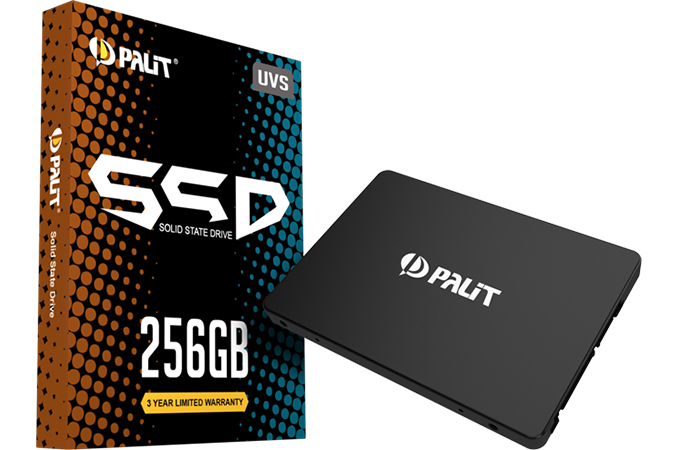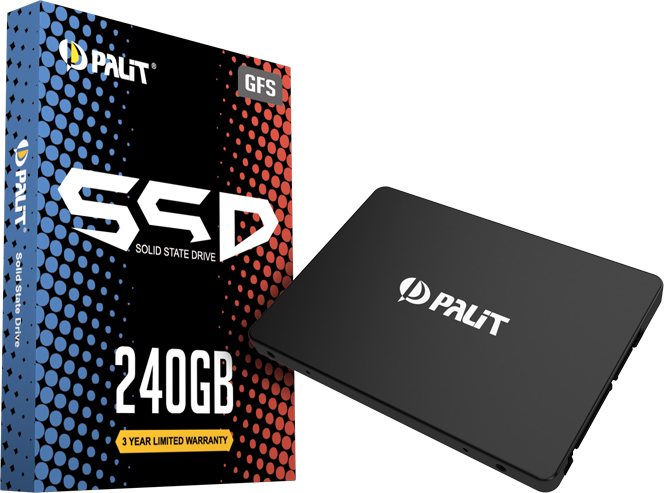A New Challenger Appears: Palit's Own-Brand UVS and GFS SSDs Announced
by Anton Shilov on April 3, 2017 11:00 AM EST
Palit has announced two families of SSDs that it plans to sell under its own brand. The new drives are aimed at entry-level and mainstream gaming PCs, and will be based on controllers from Phison using 3D MLC or 3D TLC NAND flash memory from Micron depending on which drive you pick up. The Palit SSDs will be among the first drives on the market that will use a combination of a Phison controller and 3D NAND memory ICs from Micron, but we expect this combination to spread across several SSD vendors in due course.
Palit Microsystems is one of the world’s largest producers of graphics cards, but it is not entirely new to SSDs too. Palit’s GALAX and KFA2 brands have offered Phison-based SSDs for quite a while, but their lineups have never been large and the whole effort looked more like a brand development rather than an attempt to compete against much of the market. This time, Palit has announced two families of SSDs under its own trademark and with seven drives in total, it plans to address entry-level and mainstream gaming PCs. We do not know Palit’s plans in regards of higher-end drives in M.2 or add-in-card form-factors, but such products are available from other brands that Palit owns and it should not be a problem for the company to expand its own lineup if it needs to.
Palit will initially offer two families of SSDs: First is the Palit UVS family, featuring the Phison S3111-S11 controller and 3D TLC memory for entry-level gaming systems. Then second is the Palit GFS family, based on the same Phison S3111-S11 controller but with 3D MLC NAND flash.
| Phison PS3111-S11 Controller Specifications | ||||
| PS3111-S11 | ||||
| Interface | SATA 3.2 | |||
| NAND Channels | 2 | |||
| CE Targets | 16 | |||
| DRAM Cache | Supported | |||
| ECC | LDPC | |||
| Supported Capacities | MLC | Up to 1 TB | ||
| TLC | 128 GB, 256 GB, 512 GB, 1 TB | |||
| Supported NAND | Toshiba 15 nm MLC/TLC SK Hynix 14 nm MLC/TLC Micron L06/B0KB 3D NAND NAND flash memory with 8KB and 16KB blocks. |
|||
| Additional Features | Data Compression End to End Data Path Protection |
|||
Before we start discussing the drives, let’s talk a little bit about the controller itself. Formally, the PS3111-S11 is positioned below the S10 because it has only two NAND channels with 16 CE targets and physically cannot deliver breakthrough performance. As it is a SATA controller, the PS3111-S11 does not have to deliver anything sequentially higher than 550 MB/s and this is something it can do with both MLC and TLC chips (sustained performance is a different comparison). The most important advancement of the controller versus its predecessors is that the PS3111-S11 supports LDPC ECC, and thus can be enabled on SSDs with sufficient endurance. Additionally, the PS3111-S11 supports 3D and 1z MLC/TLC NAND flash and memory with large (8 KB and 16 KB) blocks.
As for the drives, the Palit UVS family will include 120 GB, 256 GB, 480 GB and 512 GB models using 3D TLC NAND (except the 120GB, which is planar TLC). Depending on the model, the drives are rated to deliver up to 560 MB/s sequential read speed and up to 470 MB/s (370 MB/s for the 120 GB version) sequential write speed. As for random performance, the numbers on the box give 72,500 read IOPS and up to 85,000 write IOPS.
The Palit GFS lineup consists of three drives with 120 GB, 128 GB and 240 GB capacities all based on 3D MLC and offering all the endurance-related benefits of such memory. From a performance point of view, the GFS SSDs are slightly faster than the UVS drives: they are rated for up to 560 MB/s sequential read speed and up to 480 MB/s sequential write speed. Palit also states they can also perform up to 75,000 read IOPS and up to 87,500 write IOPS (240 GB version only). Palit may decide to expand the GFS lineup with higher-capacity offerings over time, but right now, its premium drives only offer entry-level capacities.
| Palit UVS and GFS SSDs Specifications | |||||||
| UVS | GFS | ||||||
| UVS10AT-SSD120 | UVS-SSD256 | UVS-SSD480 | UVS-SSD512 | GFS-SSD120 | GFS-SSD128 | GFS-SSD240 | |
| Capacity | 120 GB | 256 GB | 480 GB | 512 GB | 120 GB | 128 GB | 240 GB |
| Controller | Phison S3111-S11 | ||||||
| NAND Flash | TLC | 3D TLC NAND | 3D MLC NAND | ||||
| Sequential Read (max) | 560 MB/s | 525 MB/s | 540 MB/s | 560 MB/s | |||
| Sequential Write (max) | 375 MB/s | 470 MB/s | 465 MB/s | 450 MB/s | 480 MB/s | ||
| Random Read IOPS (max) | 70.0K | 67.5K | 72.5K | 47.5K | 75.0K | ||
| Random Write IOPS (max) | 77.5K | 85K | 87.5K | ||||
| DRAM Buffer | 32 MB | ||||||
| Pseudo-SLC Caching | Supported | ||||||
| Power Management | DevSleep 5mW | ||||||
| Form-Factor, Interface | 2.5"/7 mm, Serial ATA 3.2 | ||||||
| Warranty | 3 years | ||||||
There are two intrigues about Palit’s SSDs: the memory supplier and actual manufacturer. Typically, Phison ships its controllers with memory and firmware and in many cases even provides assembly and test services (essentially, shipping already made drives). Despite this, Palit has enough SMT lines and can produce virtually everything itself. At present, we do not know whether Palit-branded SSDs are made by Palit, or are manufactured by a third party, but the latter is clearly a possibility here.
The supplier of the NAND is also not obvious and could come from different sources. Palit does not disclose who is their supplier, but it is worth noting that Phison usually ships its controllers primarily with memory from Toshiba. We do know that there are Phison PS3111-S11-based reference designs featuring Toshiba’s BICS2 memory (which is not exactly positioned for SSDs by Toshiba) as well as S11 drives with Micron’s 3D NAND memory.
The Palit SSDs are expected to hit the market in the coming months. We do not have any information about their MSRP of the new drives, but it is logical to assume that Palit will try to make them competitive in terms of pricing.
Related Reading
Source: Palit











27 Comments
View All Comments
philehidiot - Tuesday, April 4, 2017 - link
Yeh I'm in the UK and they have quite a presence here. Not a massive brand like XFX or EVGA but stocked in most places.Lolimaster - Monday, April 3, 2017 - link
Why this companies don't simply sell shorter 2.5" SSD's? They could save a nice amount of money in shipping cost's/packaging. 1/3 of the horizontal area of a 2.5" SSD is unused.Instead of rectangular just made them a square.
mjeffer - Tuesday, April 4, 2017 - link
Which would make them incompatible with every case out there. There are reasons companies go with standard form factors.KateH - Tuesday, April 11, 2017 - link
Such things do exist, they are target at embedded systems where compactness is more important than standardization. Look around on EBay/Amazon/Alibaba and you will see compact SATA SSDs both in smaller enclosures and bare boards with no enclosure.As mjetter said, this wouldn't work for consumer SSDs because laptops, desktops & SFF PCs that take 2.5" disks are designed for 2.5" disks with a very specific enclosure size & very specific mounting points. Maybe some computers would be able to take a non-standard size disk with or without some trouble, but if you are the manufacturer why risk the extra returns and bad publicity for selling a product that cannot be guaranteed to meet compatibility expectations?
Anyways, mSATA many years ago and now M.2 are the solution for compact SSDs; 2.5" SSDs were always about compatibility with existing systems & a nonstandard form factor would defeat that purpose.
Zingam - Tuesday, April 4, 2017 - link
That means there is too much nand memory production... So why are prices so high yet?Anything under 500gb is useless.
philehidiot - Tuesday, April 4, 2017 - link
Have to disagree here. I have several SSDs in my main PC (dating back from when they were pretty small) with one being an 80GB model (which yes, is now pretty useless so just has random stuff on that isn't important as it's ageing), one being 250GB and one 512GB. Bear in mind use matters so I'd personally say if you're gaming and want shorter loading times etc then yes, you need a big SSD as you say. But if you're video editing and just need a drive for the OS, office apps and your editing apps as well as some space for the videos you're working on at the time, then 250GB is likely more than enough (unless you're working with huge 4K files in which case you're probably going to have a RAID array or something pro level). Generally once you've made the videos you just dump them onto a large, cheap HDD for archiving and that's that. Also if you just want a bog standard PC for surfing the internet and productivity but want an SSD for responsiveness, 250GB is more than enough. My SSD powered Mac has a 128GB SSD and for my use it's perfectly fine - never gets even near 50% full, has two full office suites on it (the mac version and MS version), a load of software and some videos. Remember not everyone is a power user and even those who are will often have a laptop or something which they keep relatively clean so it's nice and responsive for general browsing and so on which simply doesn't need masses of high speed storage.hojnikb - Tuesday, April 4, 2017 - link
Nice to see S11 getting some love.Will Anandtech review ssds with this controller anytime soon ?